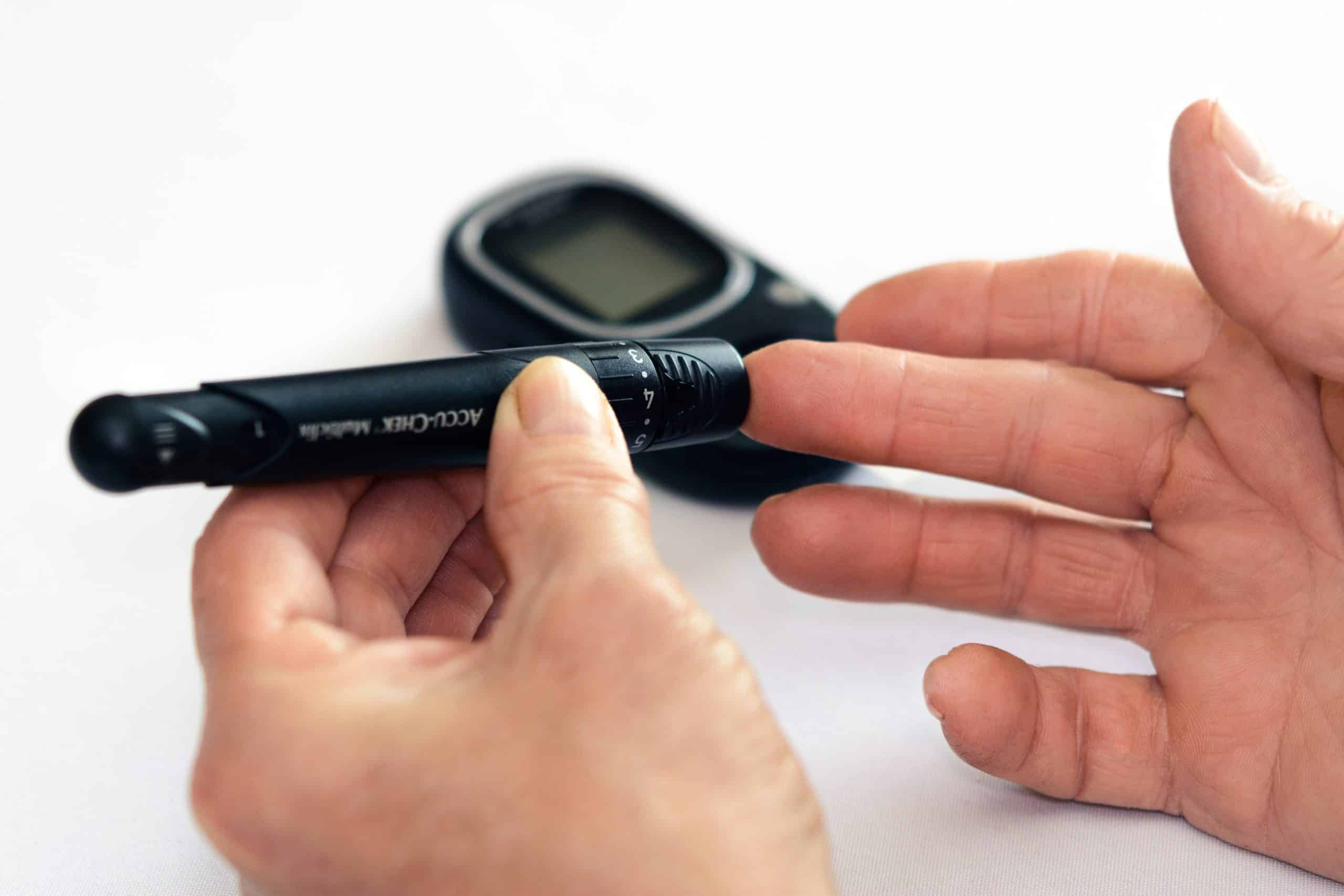Diabetes is a common diagnosis in the United States and is unfortunately a long-lasting health condition that needs to be managed continually. We will provide a brief overview of the three different types of diabetes and ways to manage these diagnoses through lifestyle changes, specifically through diet and meal planning.
Basics of Diabetes
There are three different types of diabetes: Type 1, Type 2 and Gestational, all of which affect how your body turns food into energy. The body uses blood sugar, also known as glucose, as an energy source and this glucose comes from the food that you eat and from the liver (Mayo). When functioning normally, your body breaks down the carbohydrates that you eat into blood sugar for energy and insulin is a hormone that the body needs for the glucose to get into the bloodstream (ADA). If you have diabetes, your body either doesn’t make enough insulin or it is unable to use the insulin it has efficiently, which ultimately leads to having too much blood sugar in your bloodstream. With time, this can lead to serious health issues such as heart disease, loss of vision, and kidney disease (CDC). We will now dive deeper into what distinguishes each type of diabetes.
What are the 3 Different Types of Diabetes?
Type 1: In type 1 diabetes, the body does not produce insulin, which is thought to be an autoimmune reaction (CDC). Type 1 diabetes can occur at any age, whether it be children, teens or young adults and approximately 1.25 million Americans have this condition (ADA). Of all the diabetes diagnoses, about 5% have this type of diabetes (CDC). With this diagnosis, it is necessary to take insulin every day to survive, as this is the key ingredient that your body is missing.
Type 2: With type 2 diabetes, your body is unable to use insulin effectively, thus blood sugar levels do not stay normal. Of all the people diagnosed with diabetes, about 90% have type 2 and this disease is more common in adulthood, however it is becoming more common at earlier ages (CDC). Type 2 can typically be managed or delayed with lifestyle improvements, such as weight loss, healthy eating, and increased activity levels.
Gestational diabetes: This condition typically develops in pregnant women who have not had diabetes previously and can cause higher health risks for the baby. Sometimes with pregnancy, hormones create insulin resistance and makes it challenging for the mother’s body to utilize insulin properly, which leads to this diagnosis. Nearly 10% of pregnancies in the United States are affected by gestational diabetes each year and a plan can be created with your doctor in order to work towards a healthy, safe pregnancy (ADA).
What is prediabetes?
With these diagnoses, another common condition is prediabetes, with 1 in 3 adults in the United States having this disease (CDC). About 90% of the population are not aware that they have this condition (CDC). Prediabetes is categorized as having high blood sugar levels, but not high enough to be officially diagnosed with type 2 diabetes. This diagnosis can be scary for some people, but the good news is that prediabetes can be prevented or managed with some healthy lifestyle improvements. Adjusting your lifestyle to a healthier one can help reduce the risk of developing more serious health issues in the future.
Meal Plans for Diabetics
As always, be sure to consult with your doctor regarding any diet or meal plan you plan to embark on and follow their professional recommendations. With a diabetic diagnosis, there are meal plans that are recommended and lifestyle changes that can be made in order to prevent or delay further health issues. Typically, a diabetic meal plan is sticking to a nutritious way of eating with having foods in moderate amounts and sticking to regular mealtimes in order to balance blood sugar levels. Consuming foods that are naturally high in nutrients and low in fat and calories is another important part of a diabetic diet. In general, increasing your intake of healthful foods such as fruits, vegetables and whole grains is also recommended.
With a specific diabetic diet, it is typical for your doctor to refer you to a dietitian in order to develop a meal plan that is doable and fits within your lifestyle. This plan will then help with controlling your blood sugar, managing your weight, and reducing heart disease risk factors, such as high blood pressure and high cholesterol (Mayo). We will offer some general recommendations on what specific foods to include in your diet, but with any diet changes please consult a medical professional.
Foods to Include in a Diabetic Diet Meal Plan
With following a diabetic meal plan, it is important to choose foods that are high in nutrition and that will not spike your blood sugar. Some general rules to abide by are to choose healthy carbohydrates, high-fiber foods, fish and “good” fats. Here are some examples of foods that fall into these categories with further detail:
Consume Healthy Carbs
The most important piece of advice with choosing carbs is picking those with the most “bang for your buck” with vitamins, minerals and fiber. With healthy carbohydrates, choose foods such as fruits, veggies, whole grains, legumes such as beans and peas, along with low-fat dairy products such as milk and cheese. Try to avoid less healthy carbohydrates, which includes foods or drinks with additional fats, sugars and sodium (Mayo).
Real results with a personalized weight loss program
Take the quiz!

Add More Fiber
Adding foods that are rich in fiber can aid in digestion, lower blood sugar, and reduce your risk of heart disease (ADA). Fiber comes from plants, so there is very little fiber in animal products, such as milk, eggs, meat, poultry and fish (ADA). Some high fiber foods to add to your diabetic diet include: vegetables, nuts, legumes such as dried beans, peas, lentils and whole grains (ADA). The Academy of Nutrition and Dietetics recommends consuming 14 grams for every 1000 calories per day, approximately 25 grams of dietary fiber for women and 38 grams for men each day (EatRight). These dietary fiber needs vary depending on energy expenditure levels.
Consume Fish High in Omega-3 Fatty Acids
Another type of food to add to your diet is fish and it is recommended to consume this at least twice a week by the American Diabetes Association Standards of Medical Care in Diabetes 2017, particularly fish high in omega-3 fatty acids (ADA). Omega-3 fats may help in reducing the risk of heart disease and inflammation (ADA). Fish that are rich in omega-3 fatty acids include salmon, mackerel, herring, trout, albacore tuna and sardines (ADA). When choosing these types of fish, be sure to choose ones that are not fried but rather broiled, baked, or grilled in order to reap the benefits most effectively.
“Good” Fats Vs. “Bad” Fats
Good fats are foods that contain monounsaturated and polyunsaturated fats that have the potential to decrease cholesterol levels in the body. Foods that have these “good” fats include avocados, nuts such as almonds, cashews, pecans and peanuts; olive oil and olives, peanut butter and peanut oil, sesame seeds (ADA). The American Diabetes Association recommends eating more monounsaturated fats than saturated or trans fats in your diet (ADA). With any type of food, be sure to follow the rule of moderation, particularly with fats as they are all high in calories! It can be overwhelming to follow specific food recommendations, and Noom can be there as additional support with sticking to a diabetic meal plan.
Staying on Track with a Meal Plan
As previously mentioned, always consult with your doctor before starting a meal plan. With this guidance, Noom can help support you along the way with its coaching, community support, behavior change theories, along with psychological tips and tricks that are applicable to everyday life. Noom helps you make changes step by step so it is sustainable and focuses on discovering a path that is doable for you. Everyone’s journey is different, that is why it is important to have a coach with personalized feedback and insight to brainstorm strategies and methods to overcome potential obstacles. Check out Noom today for a 2-week trial!



